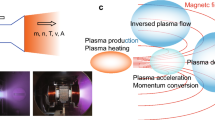Contents
At present, high power gyrotron oscillators are mainly used as generators for electron cyclotron resonance heating (ECRH) and diagnostics of magnetically confined plasmas for generation of energy by controlled thermonuclear fusion. 140 GHz gyrotrons with output powerP out =0.58 MW in the Gaussian free space TEM00 mode with pulse length up to τ=2.0 s and efficiency η=34% are commercially available. High order rotating TE-modes (e.g. TE22,6 at 140 GHz) are used as working modes in the cavities of these tubes. For plasma diagnostics higher frequencies are required. Therefore, gyrotron oscillators are designed for operation either at the second harmonic of the electron cyclotron frequency or at the fundamental cyclotron frequency with special pulsed high-field solenoids.P out =40 kW with τ=40 μs at η=4% at frequencies up to 650 GHz have been achieved. In the case of gyrotron oscillators only slow frequency step tuning is possible by variation of the magnetic field (change of operating cavity mode). Fast and continuous frequency tuning by variation of the beam acceleration voltage is feasible for free electron masers (FEM). Record output parameters are:P out =2GW, τ=20 ns, η=13% at 140 GHz (LLNL) andP out =15 kW, τ=20 μs, η=5% in the range from 120 to 900 GHz (UCSB).
Übersicht
Hochleistungs-Gyrotronoszillatoren werden derzeit vorwiegend als Generatoren für die Elektronen-Zyklotron-Resonanz-Heizung (ECRH) und Diagnostik von magnetisch eingeschlossenen Plasmen zur Erforschung der Energiegewinnung durch kontrollierte Kernfusion eingesetzt. 140 GHz Gyrotrons mit einer Ausgangsleistung vonP out =0.58 MW in der Gaußschen Freiraumgrundmode TEM00 bei Pulslängen bis zu τ=2.0 s und Wirkungsgraden η=34% sind kommerziell erhältlich. Als Arbeitsmoden im Röhrenresonator dienen dabei hohe, rotierende TE-Moden (z. B. TE22,6 bei 140 GHz). Zur Plasmadiagnostik werden höhere Frequenzen benötigt. Daher arbeiten die dazu vorgesehenen Gyroronoszillatoren entweder bei der 2. Harmonischen der Elektronen-Zyklotronfrequenz oder bei der Grundfrequenz mit speziellen gepulsten Hochfeld-Magneten. Bisher wurde bei Frequenzen bis zu 650 GHz eine HF-Ausgangsleistung vonP out =40 kW mit τ=40 μs und η=4% erreicht. Die Ausgangsfrequenz von Gyrotronoszillatoren ist dabei nur langsam und stufenweise durch Veränderung des Magnetfeldes durchstimmbar (Übergang zu anderen Arbeitswellentypen im Resonator). Schnelle und kontinuierliche Frequenzdurchstimmbarkeit (über die Beschleunigungsspannung) ist beim Frei-Elektronen-Maser (FEM) gegeben. Rekordausgangsparameter sind hier:P out =2 GW, τ=20 ns, η=13% bei 140 GHz (LLNL) undP out =15 kW, τ=20 μs, η=5% im Bereich von 120 bis 900 GHz (UCSB).
Similar content being viewed by others
References
Bratman, V. L.; Denisov, G. G.; Ginzburg, N. S.; Petelin, M. I.: IEEE Journal Quantum Electronics, QE-19 (1983) 282–296
Granatstein, V. L.; Alexeff, I.; eds.: High-power microwave sources. Artech House (1987), Boston, London
Elias, L. R.; Ramian, G.; Hu, J.; Amir, A.: Phys. Rev. Lett., 57 (1986) 424–427
Orzechwski, T. J.; Anderson, B. R.; Clark, J. G.; Fawley, W. M.; Paul, A. C.; Prosnitz, D.; Scharlemann, E. T.; Yarema, S. M.; Hopkins, D. B.; Sessler, A. M.; Wurtele, J. S.: Phys. Rev. Lett., 57 (1986) 2172–2175
Prater, R.; J. Fusion Energy, 9 (1990) 19–30
Erckmann, V.; WVII-AS Team; Kasparek, W.; Müller, G. A.; Schüller, P. G.; Thumm, M.: Fusion Technology, 17 (1990) 76–85
Thumm, M.: Proc. Vacuumelectronics and Displays, Garmisch-Partenkirchen, ITG-Fachbericht 120, VDE Verlag (1992) 63–85
Denisov, G. G.; Kuftin, A. N.; Malygin, V. I.; Venediktov, N. P.; Vinogradov D. V.; Zapevalov, V. E.: Int. J. Electronics, 72 (1992) 1079–1091
Erckmann, V. et al.: Proc. Course and Workshop on High Power Microwave Generation and Applications, Editrice Compositori Bologna (1992) 511–518
Kreischer, K. E.; Grimm, T. L.; Guss, W. C.; Temkin, R. J.; Xu, K. Y.: Proc. Int. Workshop on Strong Microwaves in Plasmas, Suzdal (1990) 713–725
Flyagin, V. A.; Kuftin, A. N.; Luchinin, A. G.; Nusinovich, G. S.; Pankratova, T. B.; Zapevalov, V. E.: Proc. Joint IAEA Techn. Committee Meeting on ECE and ECRH (EC-7 Joint Workshop), Hefei, P. R. China (1989) 355–372
Manheimer, W. M.: Int. J. Electronics, 72 (1992) 1165–1189
Brand, G. F.; Fekete, P. W.; Hong, K.; Moore, K. J.; Idehara, T.: Int. J. Electronics, 68 (1990) 1099–1111
Spira, S. E.; Kreischer, K. E.; Temkin, R. J.: Conf. Digest 13th Int. Conf. Infrared and Millimeter Waves, Honolulu, SPIE, 1039 (1988) 429–430
Idehara, T.; Tatsukawa, T.; Ogawa, I.; Shimizu, Y.; Makino, S.; Kanemaki, T.: Phys. Fluids, B5 (1993) 1377–1379
Thumm, M.: State-of-the-art of High Power Gyro-Devices and Free Electron Masers, KfK-Report 5235, 1993.
Verhoeven, A. G. A. et al.: Conf. Digest 17th Int. Conf. on Infrared and Millimeter Waves, Pasadena, Los Angeles, Proc. SPIE, 1929, (1992) 126–127
Author information
Authors and Affiliations
Rights and permissions
About this article
Cite this article
Thumm, M. Progress in the development of high-power millimeter- and submillimeter wave gyrotrons and of free electron masers. Archiv f. Elektrotechnik 77, 51–55 (1993). https://doi.org/10.1007/BF01574923
Received:
Issue Date:
DOI: https://doi.org/10.1007/BF01574923




